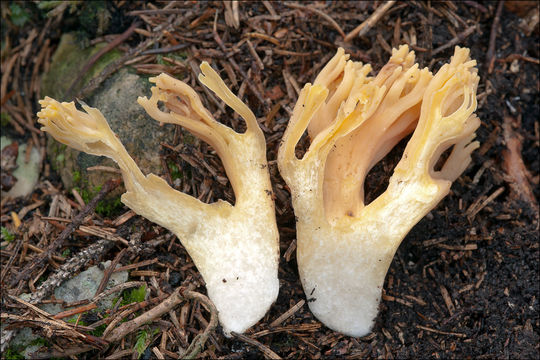Image of Ramaria longispora Marr & D. E. Stuntz 1974

Description:
Slo.: dolgospora griva (?) - Habitat: light mixed wood, Picea abies and Fagus sylvatica dominant, locally under canopies of dense stand of young Picea abies; in shade, no ground vegetations; moderately incline mountain slope, northwest aspect; calcareous ground; partly protected from direct rain by tree canopies; average precipitations ~ 3.000 mm/year, average temperature 4-6 deg C, elevation 935 m (3.070 feet), alpine phytogeographical region. Substratum: soil covered by a layer of fallen off needles of Picea abies. Comments: Ramaria longispora was originally described as a fungus of the Pacific Northwestern United States in 1973. For decades it hasn't been recorded in Europe. However, Christan (2008) (Ref.2.) described it as present also in Europe in 2008. Also Hagar (2015) (Ref.:3.) is mentioning finds in Europe. Recently done mycological survey of the region of Triglav National Park, Slovenia revealed several finds in east Julian Alps (Ref.:4.). It has been found in four UTM sub-squares of this region so far. The traits of this find fit well to literature. This species is macroscopically easy to confuse with small fruit bodies of Ramaria largentii. But Ramaria largentii has clamped basidia and hypha and somewhat smaller spores. I was unable to find clamps. Spore and basidia dimensions fit very well to literature, as well as relatively long sterigmata (average 8 microns). Also a few exceptionally long and deformed spores, which are characteristically produced by Ramaria longispora (Ref.:2) have been observed. One is shown on Picture 1M (arrow). Growing solitary; fruit body dimensions: 6 cm tall and 3.5 cm wide; stipe solid, not branched up to 2.5 cm height and about 2 cm in diameter; smell mild, pleasant, fresh, on fruits (?); taste mild pleasant, mushroomy, not bitter; SP faint, pale ocher-yellow, oac806 (?), color uncertain. Spores warty. Dimensions: 11,9 [13,5 ; 14,2] 15,8 x 4,1 [4,6 ; 4,8] 5,3 microns; Q = 2,4 [2,8 ; 3] 3,5; N = 36; C = 95%; Me = 13,8 x 4,7 microns ; Qe = 2,9. Asci dimensions: 55,6 [66 ; 71,1] 81,5 x 7,3 [9,4 ; 10,4] 12,5 microns; Q = 4,9 [6,6 ; 7,4] 9,1; N = 26; C = 95%; Me = 68,6 x 9,9 microns; Qe = 7. Olympus CH20, NEA 100x/1.25, magnification 1.000 x, oil (spores); NEA 40x/0.65, magnification 400x (asci, hypha), in water, fresh material. AmScope MA500 digital camera. Herbarium: Mycotheca and lichen herbarium (LJU-Li) of Slovenian Forestry Institute, Vena pot 2, Ljubljana, Index Herbariorum LJF Ref.: (1) R.L. Exeter, L. Norvell, E. Cazares, Ramaria of the Pacific Northwestern United States, Salem (1973), p 128. (2) J. Christan, Die Gattung Ramaria in Deutschland, IHW-Verlag (2008), p 218. (3) L. Hagar, Ottova Encyklopedia Hb, Ottova Nakladatelstvi, Praha (2015) (in Slovakian), p 484. (4) Boletus Informaticus: http://www.zdravgozd.si/bi_karta_sre.aspx?idorg=c8d733cc-0ff7-49b7-8b4c-f23687ade492
Included On The Following Pages:
- Life (creatures)
- Cellular (cellular organisms)
- Eukaryota (eukaryotes)
- Opisthokonta (opisthokonts)
- Nucletmycea
- Fungi (mushrooms, lichens, molds, yeasts and relatives)
- Dikarya
- Basidiomycota (basidiomycete fungi)
- Agaricomycetes (Mushroom-Forming Fungi)
- Gomphales
- Gomphaceae
- Ramaria
- Ramaria longispora
This image is not featured in any collections.
Source Information
- license
- cc-by-nc-sa-3.0
- copyright
- 2016 Dr. Amadej Trnkoczy
- photographer
- Dr. Amadej Trnkoczy
- original
- original media file
- visit source
- partner site
- CalPhotos
- ID


